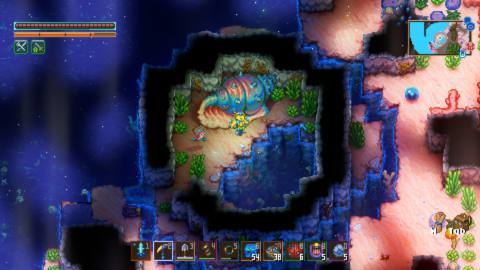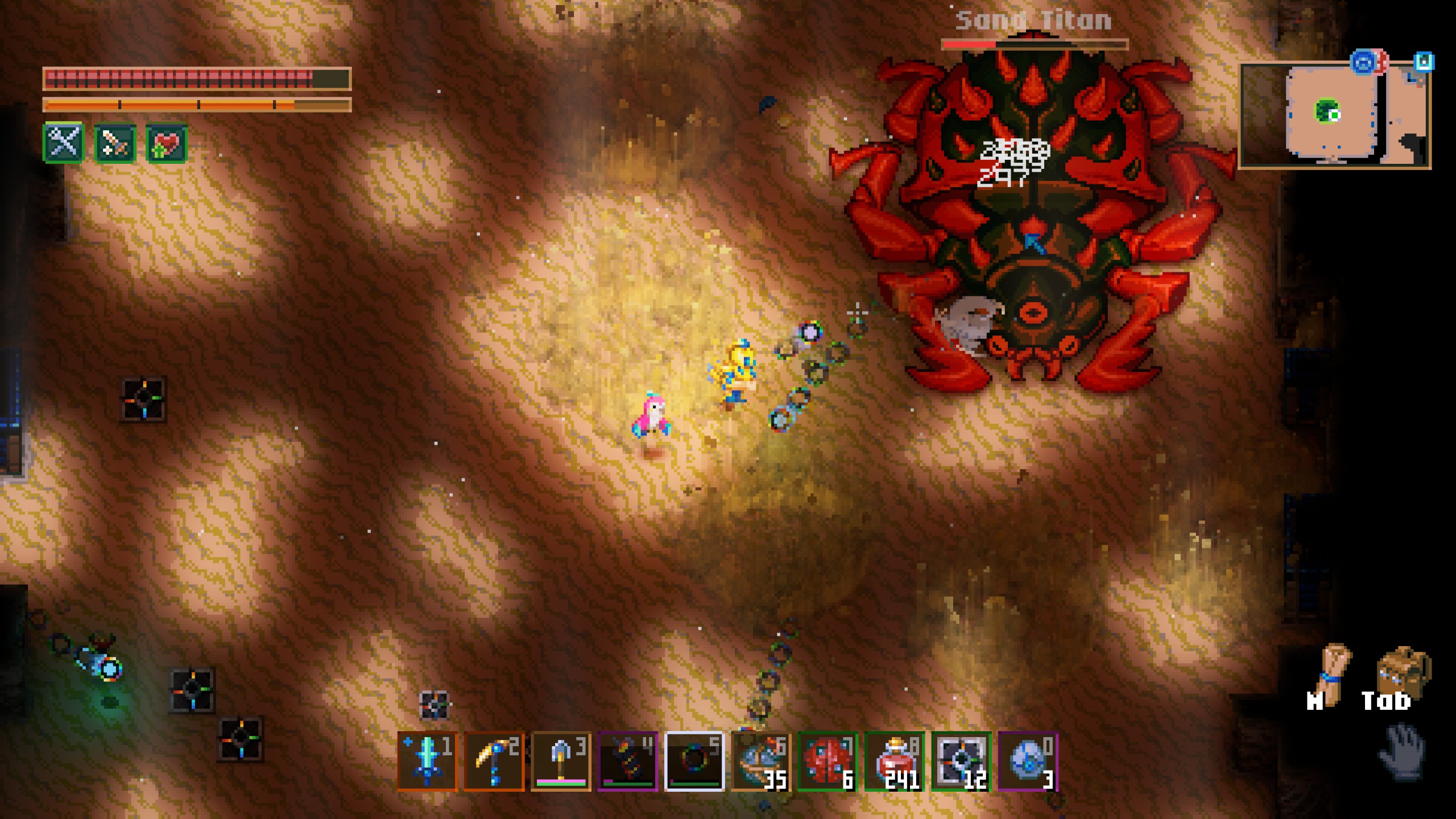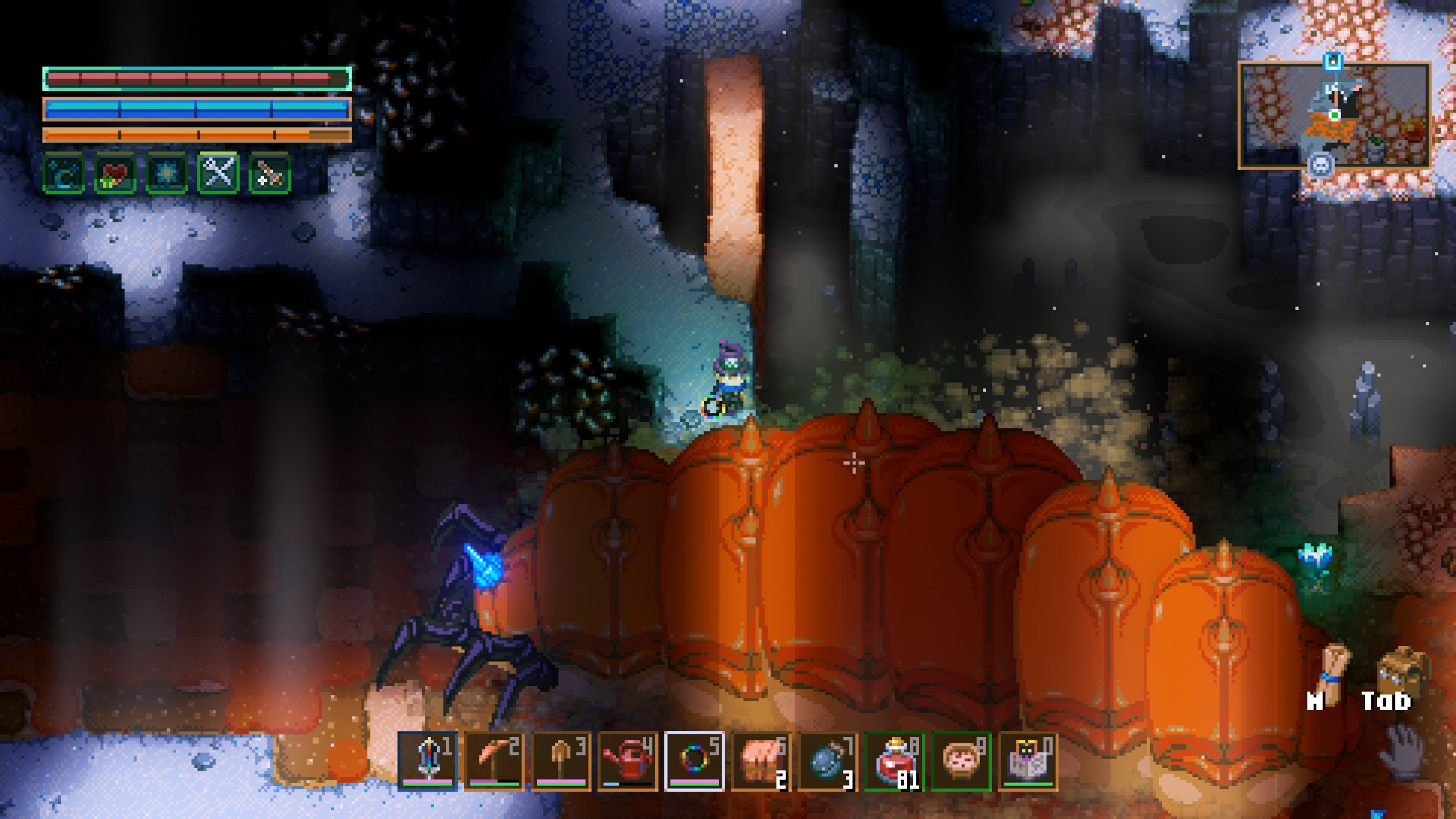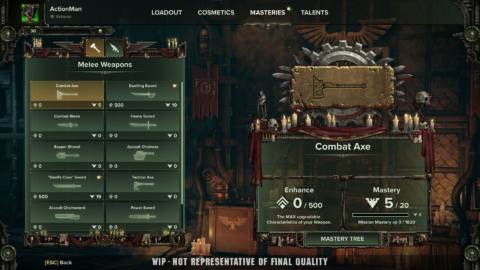What is it? A subterranean mining and crafting sandbox.
Expect to pay: $19.99/£15.99
Developer: Pugstorm
Publisher: Fireshine Games
Reviewed on: Intel i7-9700K, RTX 4070 Ti, 16GB RAM
Steam Deck: Verified
Multiplayer? 8 player co-op
Link: Official site
I wish I'd kept track of how often I said “What the heck is that?” while playing Core Keeper. It must have happened a dozen times in the first dozen hours alone, like when I came across a conch shell the size of a school bus or stumbled upon a subterranean castle 20 times the size of my base. And let's not forget when a caterpillar as big as a passenger train came stampeding through the tunnel I was exploring. WTF?
Core Keeper's got a lot in common with survival games like Valheim, plus plenty of Minecraft DNA, and even a smidge of Stardew Valley: Bizarre sights, unexpected encounters, and delightful (though dangerous) surprises are just a few things I want from a procedurally generated co-op survival crafting sandbox, and those aren't the only important items Core Keeper checks off my list.
Colorful and cute as its pixelated world is, it gets more daunting and scary the deeper you go—yet despite all its dangers and some seriously powerful bosses, it also makes for a cozy and comfy base-building experience. Plus: it's got fishing. No wonder I've sunk more than 60 hours into it.
In Core Keeper you (and your friends, since it supports up to 8 players) find yourself stranded underground in a dimly lit cave filled with ancient and defunct technology. Awakening the slumbering core means finding a way to power it up, so pick a direction and just start digging. Chip away at dirt walls, harvest the materials you find, craft new weapons and gear, build a base, and dig far-reaching tunnels outward from the core to other biomes, which include clay caverns, arid deserts, and even a vast blue ocean.
Digging in
Progress is pretty familiar if you've played some survivalcraft before: mine early resources like copper and smelt the ore into ingots to make better tools, armor, and weapons, then dig deeper into the world to find sturdier stuff like tin, gold, and iron. But it's not all about whacking walls with a pick: one of the joys of Core Keeper is setting up resource production lines so you can get machinery to do the grunt work for you.

I found a chamber with both copper and iron boulders too hardy to be carved, so I marked it on my map and came back once I'd progressed to drilling technology. Powered by an electrical generator, the drills worked around the clock to dig out those nodes while robotic arms grabbed the ore nuggets and dropped them on conveyor belts, which transported them through the tunnels I'd dug to my base.
There, another set of arms collected the ore and dropped them into a smelter to become ingots, where they were again picked up and placed in a chest next to my workbench. It took ages to set all this up, not to mention all the resources I had to collect by hand to reach that level of automation—but it was super satisfying to put into action. A world that had once been an intimidating network of darkened tunnels concealing the unknown eventually became an elaborate and efficient mining operation.

Combat isn't a particular high point of Core Keeper, and it begins as pretty crude hack-and-slash with the early threats you face, from bobbling little blobs of slime, to goblin-like Caveling tribes, to angry mushroom men. As you progress you'll find and craft new weapons like a blunderbuss—which seems a little unfair to the mushroom men—enchanted swords, magic wands, and even my favorite, the “Grubzooka,” which is like a rocket launcher made from a giant maggot. It's so powerful I no longer need to dig through dirt and stone walls, now I just 'zooka them. I'll be honest: I also blow myself up pretty frequently by accident, but it's mostly worth it.
There's also plenty of enjoyable details in the enemies you face, especially the Cavelings. At first they just seemed like mindlessly hostile goblins, but sometimes I come across one chipping away at a wall, mining for ores just like I do. I've seen several of them sleeping, because even monsters need a rest. Spend too much time on their turf and they'll send an entire patrol after you, swarming into your tunnel as if they've been rallying their troops and waiting for the perfect moment to attack. In other biomes I've even seen them growing crops on little farms. These are enjoyable details and occasionally make me wonder if maybe I'm the monster for invading their territory in search of loot.
Mine crafting

The crafting is on the simpler side, and compared to most survival crafting games I didn't need to dive into wikis all that often to figure out how it all worked. Farming and cooking are also pretty basic, but I mean that in a good way. Pop two ingredients in a pot—any two ingredients—and you'll get a meal that typically combines their properties: combining a healing berry and a flower that glows in the dark will produce a meal that heals you and makes you glow. Unfortunately, inventory management quickly becomes an issue: even with max backpack slots, I find myself having to return to base more often than I'd like just to empty my pockets from the sheer amount of stuff I've hoovered up.
Core Keeper’s lighting, effects, and animations are genuinely beautiful.
As far as progression goes, there's a bit of shared DNA with Valheim's boss system. A few of Core Keeper's bosses are already stomping around in the world—there are even several who travel around the map—but others need to be summoned by crafting a specific item. That makes defeating them easier, because you can set up the boss chamber with traps and be as prepared as possible before the fight begins.
It doesn't always help: Core Keeper's bosses are surprisingly tough, and most of them took me numerous tries and strategies before I defeated them. Like Valheim, each main boss (there are several optional ones) gives you an item you'll need to progress further, encouraging you to stray further from the safety of the core to level up your gear and weapons.

For a game that takes place entirely underground, Core Keeper does a great job of making you forget you're buried. In the early game there's darkness on all sides, banished only by placing torches or hollowing out huge caverns, but there are several biomes like the wilderness, desert, and ocean that give you the feel of being outside in the warm sunlight. Core Keeper's lighting, effects, and animations are genuinely beautiful, and making even a small base feel warm and cozy is effortless.
It's been a while since I got so drawn in by a co-op survival game, but Core Keeper's hooked me twice: once when it first entered early access in 2022, and then again when version 1.0 launched in August. It's got so much of what I enjoy in a survival experience: a big and beautiful world packed with danger that's exciting to explore, and a warm cozy base to come home to when I'm done.






